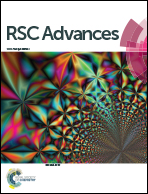TiO2 nanocrystals – assisted laser desorption and ionization time-of-flight mass spectrometric analysis of steroid hormones, amino acids and saccharides. Validation and comparison of methods†
Abstract
In the present study, the possibility for the application of TiO2 nanocrystals of various shapes and sizes, for substrate-assisted laser desorption and ionization time-of-flight mass spectrometric (SALDI TOF MS) quantitative analysis of small molecules (steroid hormones, amino acids and saccharides) was investigated. Parameters, such as homogeneity of the substrate/analyte distribution, reproducibility of the measurements, within-day, and day-to-day repeatability, were determined. The homogeneity of different nanocrystal/analyte combinations on the target plate were compared based on the signal-to-noise values of several analyte signals. Obtained results show that all TiO2 nanocrystals, regardless of their shape, have great potential for the detection and determination of steroid hormones, amino acids and saccharides with good analytical parameters and detection limits. On the other hand, the reproducibility of the S/N ratio and detectability of the analytes recorded in various modes differ depending on the substrate. All examined molecules were detectable in negative ion mode with TiO2 NTs, in contrast to all other organic matrices and substrates, and the best reproducibility was obtained with the larger nanocrystals, TiO2 PNSs and TiO2 NTs, making them good candidates for the quantitative determination of small molecules.


 Please wait while we load your content...
Please wait while we load your content...